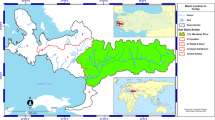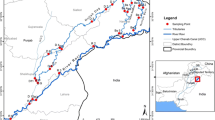Abstract
The concentration and major sources of polychlorinated biphenyls (PCBs) were evaluated in the sediments from a special environmental protection area located near a transformer maintenance and repair facility (TMRF) in Ankara, Turkey. ∑PCB concentrations analyzed on Aroclor and congener basis (seven indicator congeners) ranged from 0.1 to 84.2 and 0.1 to 21.7 ng/g dry weight, respectively. Results show that higher total PCB concentrations were localized around one of the drainage channels of the TMRF. Identity and contribution of PCB sources were predicted using a chemical mass balance (CMB) based receptor model. The CMB model typically identified Aroclor 1260, the PCB mixture frequently used in transformers, as the major PCB source confirming the effect of the TMRF on the area. Poor prediction of some sample congener profiles suggest presence of environmental degradation mechanisms such as volatilization and differential solubilization of lower chlorinated congeners from sediments.



Similar content being viewed by others
References
Acara A (2006) Turkey’s draft national implementation plan for the Stockholm convention on persistent organic pollutants, UNIDO-POPs Project No. GF/TUR/03/008. Ministry of Environment and Forestry, Ankara, Turkey (in Turkish)
Breivik K, Sweetman A, Pacyna JM, Jones KC (2007) Towards a global historical emission inventory for selected PCB congeners—a mass balance approach: 3. An update. Sci Tot Environ 377(2–3):296–307
Carlon C, D’Alessandro M, Swartjes F (2007) Derivation methods of soil screening values in Europe. A review and evaluation of national procedures towards harmonisation, European Commission. EUR 22805-EN. Joint Research Centre, Ispra
Cheng MD, Hopke P (1986) Investigation on the use of chemical mass balance receptor model: numerical computations. Chemomet Intell Lab Syst 1:33–50
Chiarenzelli JR, Scrudato RJ, Wunderlich ML (1997) Volatile loss of PCB Aroclors from subaqueous sand. Environ Sci Technol 31(2):597–607
Christensen ER, Li A, Ab Razak IA, Rachdawong P, Karls JF (1997) Sources of polycyclic aromatic hydrocarbons in sediments of the Kinnickinnic River, Wisconsin. J Great Lakes Res 23(1):61–73
Chu WK, Wong MH, Zhang J (2006) Accumulation, distribution and transformation of DDT and PCBs by phragmites Australis and Oryza sativa L.: I. Whole plant study. Environ Geochem Health 28:159–168
Collins C, Fryer M, Grosso A (2006) Plant uptake of non-ionic organic chemicals. Environ Sci Tech 40:45–52
Demircioglu F (2010) Application of two receptor models for the investigation of sites contaminated with polychlorinated biphenyls: positive matrix factorization and chemical mass balance. M.S. thesis. Department of Environmental Engineering. Middle East Technical University, Ankara, Turkey
Dodoo DK, Essumang DK, Jonathan JWA, Bentum JK (2012) Polychlorinated biphenyls in coastal tropical ecosystems: distribution, fate and risk assessment. Environ Res 118:16–24
Erickson MD (1997) Analytical chemistry of PCBs. CRC-Lewis Publishers, Boca Raton
Erickson MD, Kaley RG (2011) Applications of polychlorinated biphenyls. Environ Sci Pollut Res 18(2):135–151
Frame GM, Cochran JW, Bowadt SS (1996) Complete PCB congener distributions for 17 Aroclor mixtures determined by 3 HRGC systems optimized for comprehensive, quantitative, congener-specific analysis. J High Resolut Chromatogr 19:657–668
Gedik K (2010) Occurrence, distribution and sources of polychlorinated biphenyls at selected industrial sites in Turkey. Ph.D thesis. Department of Environmental Engineering. Middle East Technical University, Ankara, Turkey
Gedik K, Imamoglu I (2010) An assessment of the spatial distribution of polychlorinated biphenyl contamination in Turkey. Clean: Soil, Air, Water 38(2):117–128
Gedik K, Imamoglu I (2013) Levels, distribution, and sources of polychlorinated biphenyls in sediments of Lake Eymir, Turkey. Arch Environ Contam Toxicol. doi:10.1007/s00244-013-9900-x
Gedik K, Demircioglu F, Imamoglu I (2010) Spatial distribution and source apportionment of PCBs in sediments around Izmit industrial complexes, Turkey. Chemosphere 81(8):992–999
Gomez-Gutierrez A, Garnacho E, Bayona JM, Albaiges J (2007) Assessment of the mediterranean sediments contamination by persistent organic pollutants. Environ Pollut 148(2):396–408
Heiri O, Lotter AF, Lemcke G (2001) Loss on ignition as a method for estimating organic and carbonate content in sediments: reproducibility and comparability of results. J Paleolimnol 25:101–110
Henry RC, Lewis CW, Hopke PK, Williamson HJ (1984) Review of receptor model fundamentals. Atmos Environ 18(8):1507–1515
Honda T, Wada M, Nakashima K (2008) Concentration and characteristics of polychlorinated biphenyls in the sediments of sea and river in Nagasaki prefecture, Japan. J Health Sci 54(4):400–408
Hopke PK (1991) An introduction to receptor modeling. Chemomet Intell Lab Syst 10:21–43
Imamoglu I, Christensen ER (2002) PCB sources, transformations and contributions in recent Fox River, Wisconsin sediments determined from receptor modeling. Water Res 36:3449–3462
Imamoglu I, Li K, Christensen ER (2002) PCB sources and degradation in sediments of Ashtabula River, Ohio, USA, determined from receptor models. Water Sci Technol 46(3):89–96
Imfeld G, Braeckevelt M, Kuschk P, Richnow HH (2009) Monitoring and assessing processes of organic chemicals removal in constructed wetlands. Chemosphere 74:349–362
Ishikawa Y, Noma Y, Mori Y, Sakai S (2007) Congener profiles of PCB and a proposed new set of indicator congeners. Chemosphere 67:1838–1851
Li YF, Harner T, Liu LY, Zhang Z, Ren NQ, Jia HL et al (2010) Polychlorinated biphenyls in global air and surface soil: distributions, air-soil exchange, and fractionation effect. Environ Sci Technol 44(8):2784–2790
Ogura I, Gamo M, Masunaga S, Nakanishi J (2005) Quantitative identification of sources of dioxin-like polychlorinated biphenyls in sediments by a factor analysis model and a chemical mass balance model combined with Monte Carlo techniques. Environ Toxicol Chem 24:277–285
Ozyurek NA, Gedik K, Siltu E, Imamoglu I (2013) Levels and sources of polychlorinated biphenyls in Ankara creek sediments, Turkey. J Environ Sci Health, Part A 48:1–9
Rachdawong P (1997) Receptor models for source attribution of PAHs and PCBs in Lake Michigan sediments. Ph.D thesis. Department of Civil Engineering and Mechanics. University of Wisconsin-Milwaukee
Turkish official gazette (TOG) (1990) The council of ministers’ decision #90/1117 in 22 October 1990. http://www.resmigazete.gov.tr/arsiv/20702.pdf. Accessed 23 April 2013
Yeniova M (1998) Biological and environmental monitoring of polychlorinated biphenyls. Ph.D thesis. Ankara University, Ankara, Turkey (in Turkish)
Acknowledgments
This study was funded by the Turkish Scientific and Research Council (TUBITAK: CAREER Project No: 104I126).
Author information
Authors and Affiliations
Corresponding author
Rights and permissions
About this article
Cite this article
Karakas, F., Gedik, K. & Imamoglu, I. Apportionment of PCB Sources Near a Transformer Maintenance and Repair Facility in Ankara, Turkey. Bull Environ Contam Toxicol 91, 141–147 (2013). https://doi.org/10.1007/s00128-013-1019-2
Received:
Accepted:
Published:
Issue Date:
DOI: https://doi.org/10.1007/s00128-013-1019-2




